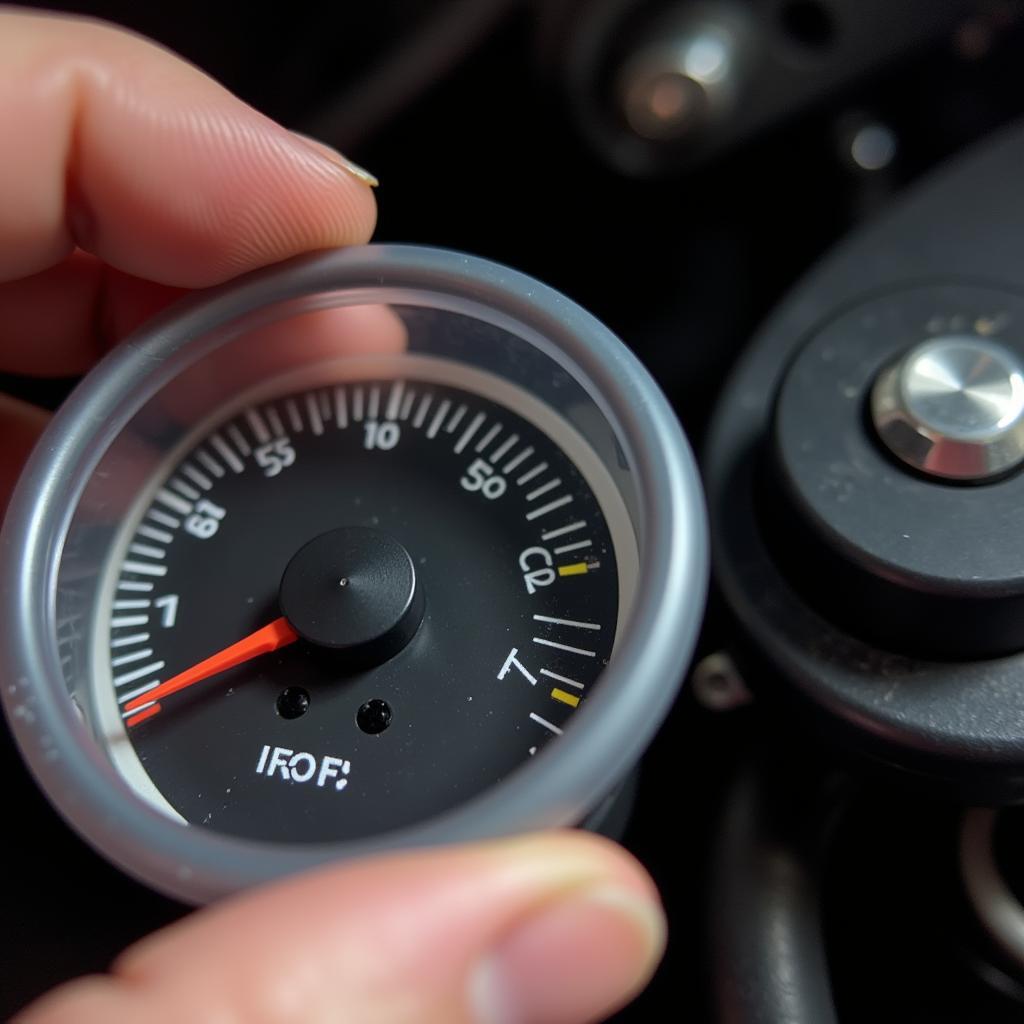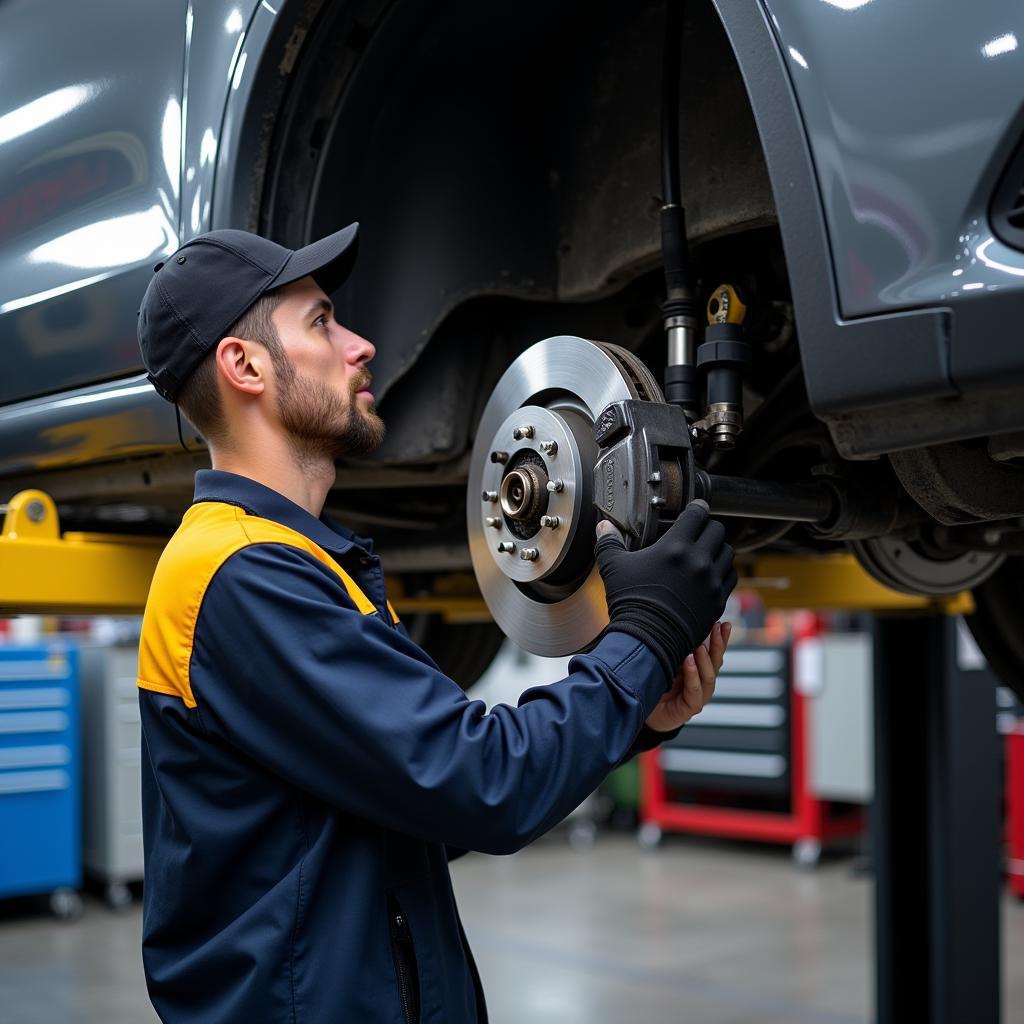A warning light for brakes on your dashboard is a clear sign that something isn’t right with your braking system and should never be ignored. This light could be indicating a range of issues from minor to serious, and understanding what they are can help you take the right action. This article dives into the common causes of a brake warning light, how to troubleshoot them, and what to do when the light comes on.
Common Causes of a Warning Light for Brakes
Several factors can trigger the warning light for brakes in your vehicle. Here are some of the most common culprits:
- Low Brake Fluid: Your brake system operates using hydraulic pressure created by brake fluid. If the fluid level is low, this pressure is compromised, triggering the warning light. This could indicate a leak in the system.
- Worn Brake Pads: Brake pads are designed to wear down over time. When they become too thin, a sensor within the brake pad will trigger the warning light, indicating the need for a replacement.
- Faulty ABS System: Modern vehicles are equipped with an Anti-lock Braking System (ABS), which prevents wheel lockup during hard braking. If there’s a problem with your ABS system, such as a malfunctioning sensor, the warning light may illuminate.
- Parking Brake Engaged: It may seem obvious, but leaving your parking brake even slightly engaged can trigger the warning light. Always ensure it’s fully released before driving.
- Brake Light Issues: While not directly related to braking power, a faulty brake light switch or bulb can also trigger the brake warning light in some vehicles. This is because the systems are often linked for safety reasons.
Troubleshooting a Warning Light for Brakes
 Checking Brake Fluid Level
Checking Brake Fluid Level
If your brake warning light comes on, here’s a step-by-step guide on how to troubleshoot the problem:
- Check Your Parking Brake: Before panicking, make sure your parking brake is fully disengaged. If it’s even slightly on, it can trigger the light.
- Inspect Brake Fluid Level: Park your car on a level surface and locate the brake fluid reservoir. The reservoir is usually translucent, allowing you to see the fluid level. It’s typically marked with “Min” and “Max” lines. If the fluid level is below the “Min” line, it needs to be topped up. However, be cautious – a significantly low fluid level can indicate a leak in the system, requiring immediate professional attention.
- Visually Inspect Your Brakes: If possible, take a look at your brake pads and rotors. Can you see significant wear on the pads? Are the rotors scored or grooved? If you notice any concerning signs, it’s best to have your brakes inspected by a mechanic.
- Consult Your Owner’s Manual: Your vehicle’s owner’s manual is a valuable resource for understanding the specific warning lights on your dashboard. It can provide detailed information about the meaning of the brake warning light and any recommended actions.
- Seek Professional Help: If you’re unable to identify the cause of the warning light for brakes or are uncomfortable performing any troubleshooting steps, it’s crucial to seek professional assistance. A qualified mechanic can diagnose the issue accurately and perform the necessary repairs.
What Happens If I Ignore the Warning Light?
Ignoring a warning light for brakes is incredibly risky. It can lead to:
- Reduced Braking Efficiency: Driving with worn brake pads, low brake fluid, or a faulty ABS system compromises your car’s ability to stop effectively, significantly increasing the risk of an accident.
- Complete Brake Failure: In extreme cases, ignoring the warning light can lead to complete brake failure, making it impossible to stop your vehicle and potentially resulting in a serious collision.
- Costly Repairs: Addressing a brake problem early is crucial. Ignoring the warning light often leads to more extensive and expensive repairs down the line.
Remote Diagnostics and Programming for Brake Issues
Advancements in automotive technology have paved the way for remote diagnostics and programming, providing innovative solutions for brake issues:
- Remote Diagnostics: Some car manufacturers and specialized service providers offer remote diagnostic services. This technology allows mechanics to remotely access your vehicle’s computer system, read error codes related to the brake warning light, and get a better understanding of the issue without physically inspecting the car. This can speed up the diagnostic process and help determine the best course of action.
- Software Updates and Programming: Modern vehicles heavily rely on software for various functions, including braking systems. In some instances, a software glitch or outdated software could trigger the warning light. Remote programming allows technicians to install software updates or patches wirelessly, potentially resolving the issue without the need for a physical visit to the repair shop.
These advancements highlight the evolving landscape of car repair, offering convenience and efficiency for car owners dealing with brake system issues.
The Importance of Proactive Brake Maintenance
 Mechanic Inspecting Car Brakes
Mechanic Inspecting Car Brakes
Prevention is always better than cure, especially when it comes to your car’s braking system. Here’s why proactive brake maintenance is essential:
- Safety: Properly maintained brakes ensure optimal braking performance, reducing the risk of accidents caused by brake failure.
- Cost Savings: Addressing minor brake issues early on can prevent them from escalating into major, costly repairs. Regular inspections allow mechanics to identify potential problems before they become serious.
- Improved Vehicle Lifespan: Taking care of your brakes can extend the lifespan of other components in your vehicle, such as rotors and calipers, saving you money in the long run.
Schedule regular brake inspections and maintenance with a trusted mechanic, follow the manufacturer’s recommended service intervals, and address any warning lights promptly to keep your brakes in optimal condition.
Conclusion
A warning light for brakes is never something to ignore. By understanding its potential causes and taking prompt action, you prioritize your safety and the well-being of your vehicle. Whether it’s a simple fix like adding brake fluid or a more complex issue requiring professional attention, addressing the problem head-on ensures you can continue to drive with confidence. Remember, when it comes to brakes, proactive maintenance is always the best approach.
FAQs
Q: Can I drive my car with the brake warning light on?
A: While you might be able to drive a short distance, it’s highly discouraged. Driving with the brake warning light on puts you at risk of reduced braking efficiency or even complete brake failure.
Q: How often should I change my brake pads?
A: There’s no one-size-fits-all answer, as brake pad lifespan depends on driving habits and conditions. However, it’s generally recommended to have them inspected every 12,000 miles and replaced when they wear down to the minimum thickness.
Q: How can I prevent my brake warning light from coming on?
A: Regular brake inspections, timely brake fluid top-ups, and addressing any signs of brake problems early on can help prevent the warning light from illuminating.
Q: Can extreme temperatures affect my brakes?
A: Yes, extreme heat can cause brake fluid to overheat and reduce its effectiveness, while extreme cold can impact brake fluid viscosity. If you live in an area with extreme temperatures, it’s crucial to be mindful of your brakes.
Q: What does it mean if my brake pedal feels spongy?
A: A spongy brake pedal is often a sign of air in the brake lines, which can significantly reduce braking performance. It’s crucial to have this addressed by a professional mechanic immediately.
